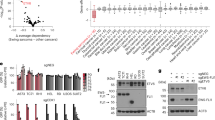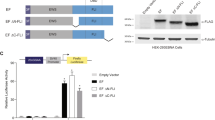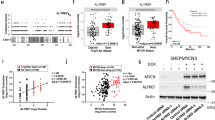Abstract
To gain insight into the tumor suppressor properties of E2F1, we investigated growth inhibition by the E2F family of transcription factors using a tissue culture model system. We first show that exogenous E2F expression causes an 80% decrease in NIH3T3 colony formation and activated c-Ha-Ras-mediated focus formation. Inhibition of Ras-mediated transformation was dependent upon E2F DNA binding activity but did not require amino- or carboxy-terminal E2F1 protein interaction domains. Because E2F upregulation has been suggested to be associated with a neoplastic phenotype, it was possible that increased E2F activity would not be inhibitory to previously transformed cells. However, we found that exogenous E2F was also inhibitory to growth of NIH3T3 cells previously transformed by Ras or Neu. Further characterization revealed that exogenous E2F expression is inhibitory at very early times after transfection, causing dramatic losses in transfected cell populations. Interestingly, those few cells which do establish appear to be unaffected by the overexpressed E2F. Therefore, we propose that increased E2F activity may only be tolerated in a subset of cells which have acquired specific alterations that are dominant over E2F-mediated growth inhibition.
This is a preview of subscription content, access via your institution
Access options
Subscribe to this journal
Receive 50 print issues and online access
$259.00 per year
only $5.18 per issue
Buy this article
- Purchase on Springer Link
- Instant access to full article PDF
Prices may be subject to local taxes which are calculated during checkout






Similar content being viewed by others
References
Bargmann CI, Hung M-C and Weinberg RA . 1986 Cell 45: 649–657
Beijersbergen RL, Kerkhoven RM, Zhu L, Carlée L, Voorhoeve PM and Bernards R . 1994 Genes Dev 8: 2680–2690
Brideau AD, Banfield BW and Enquist LW . 1998 J Virol 72: 4560–4570
Chen C and Okayama H . 1987 Mol Cell Biol 7: 2745–2752
Cress WD, Johnson DG and Nevins JR . 1993 Mol Cell Biol 13: 6314–6325
Dignam JD, Lebovitz RM and Roeder RG . 1983 Nucleic Acids Res 11: 1475–1489
Dimri GP, Hara E and Campisi J . 1994 J Biol Chem 269: 16180–16186
Ferreira R, Magnaghi-Jaulin L, Robin P, Harel-Bellan A and Trouche D . 1998 Proc Natl Acad Sci USA 95: 10493–10498
Field SJ, Tsai F-Y, Kuo F, Zubiaga AM, Kaelin Jr WG, Livingston DM, Orkin SH and Greenberg ME . 1996 Cell 85: 549–561
Finlay C, Hinds P and Levine A . 1989 Cell 57: 1083–1093
Flores AM, Kassatly RF and Cress WD . 1998 Oncogene 16: 1289–1298
Gumerlock PH, Meyers FJ, Kokoris SP, Wong G, McCormick FP and de Vere White RW . 1989 Anal Biochem 180: 158–168
Hammerschmidt W, Sugden B and Baichwal VR . 1989 J Virol 63: 2469–2475
Helin K, Harlow E and Fattaey A . 1993a Mol Cell Biol 13: 6501–6508
Helin K, Wu C-L, Fattaey AR, Lees JA, Dynlacht BD, Ngwu C and Harlow E . 1993b Genes Dev 7: 1850–1861
Hsieh J-K, Fredersdorf S, Kouzarides T, Martin K and Lu X . 1997 Genes Dev 11: 1840–1852
Huang H-JS, Yee J-K, Shew J-Y, Chen P-L, Bookstein R, Friedmann T, Lee EY-HP and Lee W-H . 1988 Science 242: 1563–1566
Ivey-Hoyle M, Conroy R, Huber HE, Goodhart PJ, Oliff A and Heimbrook DC . 1993 Mol Cell Biol 13: 7802–7812
Johnson DG, Cress WD, Jakoi L and Nevins JR . 1994 Proc Natl Acad Sci USA 91: 12823–12827
Kalejta RF, Brideau AD, Banfield BW and Beavis AJ . 1999 J Exp Cell Res 248: 322–328
Karlsreder J, Rotheneder H and Wintersberger E . 1996 Mol Cell Biol 16: 1659–1667
Kitagawa M, Higashi H, Suzuki-Takahashi I, Segawa K, Hanks SK, Taya Y, Nishimura S and Okuyama A . 1995 Oncogene 10: 229–236
Krek W, Ewen ME, Shirodkar S, Arany Z, Kaelin WGJ and Livingston DM . 1994 Cell 78: 161–172
Krek W, Xu G and Livingston DM . 1995 Cell 83: 1149–1158
Lees JA, Saito M, Vidal M, Valentine M, Look T, Harlow E, Dyson N and Helin K . 1993 Mol Cell Biol 13: 7813–7825
Lin SY, Black AR, Kostic D, Pajovic S, Hoover CN and Azizkhan JC . 1996 Mol Cell Biol 16: 1668–1675
Lindeman GJ, Gaubatz S, Livingston DM and Ginsberg D . 1997 Proc Natl Acad Sci USA 94: 5095–5100
Magae J, Wu C-L, Illenye S, Harlow E and Heintz NH . 1996 J Cell Sci 109: 1717–1726
Maniatis T, Fritsch EF and Sambrook J . 1982 Molecular cloning; a laboratory manual Cold Spring Harbor Laboratory Cold Spring Harbor, New York
Marti A, Wirbelauer C, Scheffner M and Krek W . 1999 Nature Cell Biol 1: 14–19
Müller H, Moroni M, Vigo E, Peterson BO, Barteck JH and Helin K . 1997 Mol Cell Biol 17: 5508–5520
Phillips AC, Bates S, Ryan KM, Helin K and Vousden KH . 1997 Genes Dev 11: 1853–1863
Pierce AM, Fisher SM, Conti DJ and Johnson DG . 1998a Oncogene 16: 1267–1276
Pierce AM, Gimenez-Conti IB, Schneider-Broussard R, Martinez LA, Conti CJ and Johnson DG . 1998b Proc Natl Acad Sci USA 95: 8858–8863
Pierce AM, Schneider-Broussard S, Gimenez-Conti IB, Russell JL, Conti CJ and Johnson DG . 1999 Mol Cell Biol 19: 6408–6414
Roussel MF, Davis JN, Cleveland JL, Ghysdael J and Hiebert SW . 1994 Oncogene 9: 405–415
Saito M, Helin K, Valentine MB, Griffith BB, Willman CL, Harlow E and Look AT . 1995 Genomics 25: 130–138
Sellers WR, Rodgers JW and Kaelin Jr WG . 1995 Proc Natl Acad Sci USA 92: 11544–11548
Singh P, Wong SH and Hong W . 1994 EMBO J 13: 3329–3338
Verona R, Moberg K, Estes S, Starz M, Vernon JP and Lees JA . 1997 Mol Cell Biol 17: 7268–7282
Wang B, Kennan WS, Yasukawa-Barnes J, Lindstrom MJ and Gould MN . 1991a Cancer Res 51: 2642–2648
Wang B, Kennan WS, Yasukawa-Barnes J, Lindstrom MJ and Gould MN . 1991b Cancer Res 51: 5649–5654
Wells J, Held P, Illenye S and Heintz NH . 1996 Mol Cell Biol 16: 634–647
Wu CL, Zukerberg LR, Ngwu C, Harlow E and Lees JA . 1995 Mol Cell Biol 15: 2536–2546
Xu M, Sheppard KA, Peng CY, Yee AS and Piwnica-Worms H . 1994 Mol Cell Biol 14: 8420–8431
Yamasaki L, Jacks T, Bronson R, Goillot E, Harlow E and Dyson NJ . 1996 Cell 85: 537–548
Zhu L, van den Heuvel S, Helin K, Fattaey A, Ewen M, Livingston D, Dyson N and Harlow E . 1993 Genes Dev 7: 1111–1125
Acknowledgements
We are grateful to Richard Burgess, Doug Cress, LW Enquist, Doron Ginsberg, Michael Gould, Ed Harlow, Kristen Helin, Wilhelm Krek, Jackie Lees, David Livingston, Joseph Nevins, Bill Sugden and Phillip Watson for providing plasmids and reagents and to Kathy Schell and Kristen Elmer for assistance with flow cytometry. We also thank members of the Farnham laboratory for critical readings of this manuscript. This work was supported in part by Public Health Service Grants CA07175, CA22484 and predoctoral training grants CA09135 and DAMD17-96-1-6109.
Author information
Authors and Affiliations
Rights and permissions
About this article
Cite this article
Lee, T., Farnham, P. Exogenous E2F expression is growth inhibitory before, during, and after cellular transformation. Oncogene 19, 2257–2268 (2000). https://doi.org/10.1038/sj.onc.1203556
Received:
Revised:
Accepted:
Published:
Issue Date:
DOI: https://doi.org/10.1038/sj.onc.1203556



